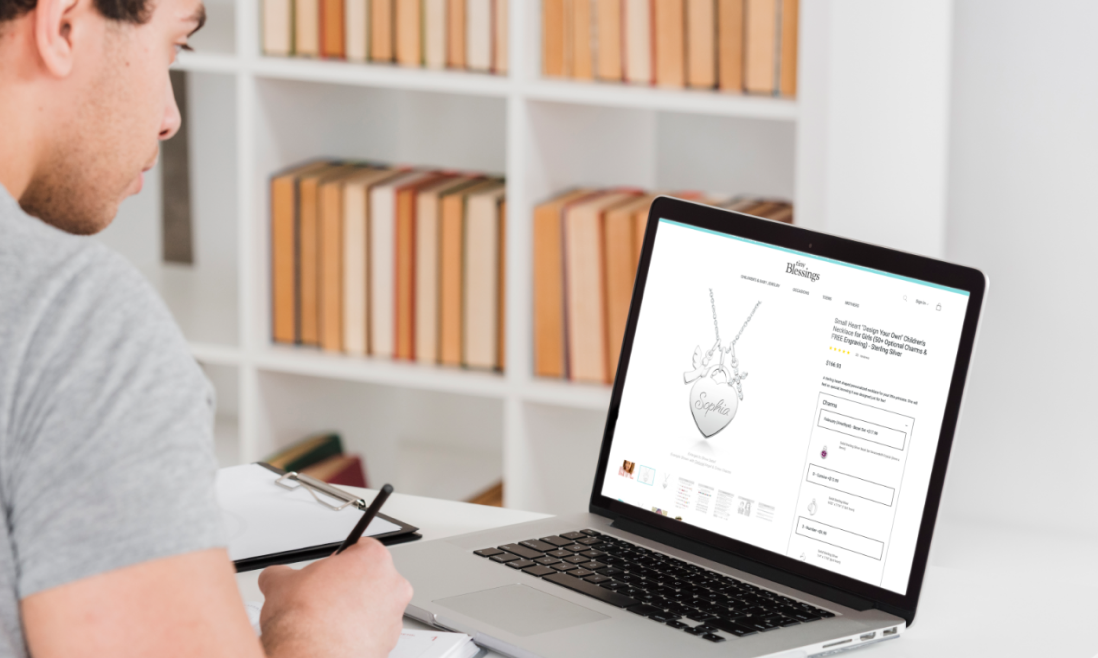What if you could design your dream product with just a few clicks on your favorite online store? You can, in fact.
Welcome to the exciting world of ecommerce product configurators. These tools are changing how we shop online by letting us personalize what we buy.
In this blog post, we’re going to take a close look at these configurators. You’ll learn what they are, how they work, and why they’re a big deal for online stores. We’ll show you examples from different brands that use this cool tech to make shopping better. Plus, we’ll talk about some of the best software out there for creating these configurators.
Get ready to dive into the future of shopping online!
What is an Ecommerce Product Configurator?
An ecommerce product configurator is an innovative, interactive software tool designed to enhance the online shopping experience. It allows users to personalize products according to their preferences, offering a DIY approach to customizing product appearance and, occasionally, functionality. This tool is integral to e-commerce platforms, especially for businesses that support customization services.
Here are some key features of e-commerce product configurators:
- Interactive Customization: Users can modify various aspects of a product, such as size, color, text, texture, and images. This feature enables customers to create a product that matches their specific needs and tastes.
- Real-Time Visualization: The configurator acts as a simulation tool, continuously visualizing changes to the product as customers make real-time adjustments. This functionality provides a more accurate and tangible representation of the final product, enhancing customer confidence in their purchase decisions.
- Diverse Application: Ecommerce product configurators are versatile and can be applied to a wide range of products. For instance, in an online store selling jackets, customers can experiment with different designs, colors, and sizes through a visual configurator.
Today’s e-commerce environment demands more than just static images to showcase products. Product configurators offer dynamic, 3D, and AR visualizations, providing a comprehensive and engaging view of products. This advanced visualization is crucial in markets like footwear, jewelry, apparel, and custom products like print-on-demand T-shirts or personalized jewelry.
Why Should You Use an Ecommerce Product Configurator?
The adoption of an ecommerce product configurator is more than just a technological upgrade. It’s a strategic move towards offering a more personalized, engaging, and efficient online shopping experience. Here are the key reasons why incorporating a product configurator can be a game-changer for your ecommerce business:
Enhanced Customer Experience
Product configurators provide customers with a deeply personalized shopping experience. By allowing them to craft products to their liking, customers gain a sense of ownership, potentially increasing their loyalty and reducing bounce rates.
These tools enable customers to visualize their customizations in real-time, offering a clear picture of the final product. This clarity boosts confidence in their purchase decisions, enhancing overall customer satisfaction.
Higher Conversion Rates
Customizable products, being unique and personally crafted, often hold more value to customers. This perceived value can lead to a higher likelihood of purchase and willingness to spend more. The time and effort customers invest in personalizing a product also creates a sense of attachment, increasing the likelihood of conversion.
Competitive Advantage
Offering a dynamic and interactive product customization experience can set your ecommerce store apart from competitors, attracting more customers. Tools like AR and 3D visualization are particularly appealing to millennials and Gen Z shoppers, helping to capture a broader market.
Common eCommerce Product Configurator Types
In the dynamic world of eCommerce, product configurators have become essential tools, enhancing customer engagement and satisfaction. These configurators offer unique advantages and cater to different customer needs. Choosing the right type depends on the nature of the products, the industry, and the desired customer experience.
Here are four of the most popular types of product configurators used in eCommerce, each catering to different business needs and customer experiences:
1. Web to Print Configurators
- Ideal for: Businesses specializing in customizable products like clothing and beverages.
- Functionality: Customers can design prints or patterns on products, offering a personalized touch.
- Example: A clothing brand enabling customers to add unique designs or text to T-shirts.
2. 3D Configurators
- Ideal for: Industries such as jewelry and furniture, where visual detail is crucial.
- Functionality: Offers realistic 3D models of products, allowing customers to explore various customizations like color, material, and design.
- Example: A furniture store where customers can modify design elements of a sofa, including fabric type, color, and accessories.
3. AR Viewer Configurators
- Ideal for: High-value items such as cars and interior design products.
- Functionality: Provides an immersive experience by placing 3D models of products in real-life settings, enhancing the customer’s ability to visualize the product in their own space.
- Example: An automobile showroom offering a virtual experience where customers can view different car models and features in a realistic setting.
4. Virtual Try-On Configurators
- Ideal for: Products like shoes, clothing, and eyewear.
- Functionality: Allows customers to virtually try on products using their smartphones, helping them visualize how the items would look on them.
- Example: An eyewear store where customers can see how different glasses frames would look on their face using an app.
Best Practices for Product Configurator in Ecommerce
A well-designed product configurator can significantly enhance the eCommerce shopping experience, leading to higher customer satisfaction and increased sales. By following these best practices, businesses can ensure that their product configurators are user-friendly, efficient, and effective in meeting the diverse needs of their customers.
1. Design for Mobile First
In today’s digital era, prioritizing mobile-first design for your eCommerce product configurator is crucial. Given the smaller screen size of mobile devices, it’s essential to ensure that buttons and text are large enough for easy interaction.
Moreover, while it might be challenging to incorporate all desktop features into the mobile version, maintaining consistency across both platforms is vital to prevent discrepancies in user experience. Therefore, it’s advisable to develop the mobile version first, then carefully adapt it for desktop, ensuring a seamless transition between the two.
2. Ease Users into the Configurator
For customers who are not tech-savvy or new to product configurators, it’s important to provide a user-friendly introduction to the software. Overwhelming customers with complex features right away can lead to confusion, especially if your product has a high level of customization.
To counter this, start with easy-to-understand elements, progressively introducing more complex features. Clear instructions and avoiding industry jargon can also help make the configurator more accessible to all users.
3. Provide Users Autonomy to Skip Steps
It’s essential to recognize that not all customers will want to engage deeply with every customization option. To cater to this, adding a feature that allows users to skip certain steps in the customization process can enhance the user experience.
This autonomy ensures that customers who prefer a more straightforward approach can still achieve satisfactory results without navigating through all customization steps.
4. Implement a Save and Restart Mode
Incorporating a save and restart feature in the configurator is essential for enhancing user convenience. This feature allows users to save their customization process and return to it at a later time, thereby encouraging them to complete their customization without feeling rushed.
Offering various methods for saving progress, such as unique links or account-based saving, caters to different user preferences and enhances the overall experience.
Real World Examples of eCommerce Product Configurator
In the fast-paced world of online shopping, eCommerce product configurators have become a game-changer. To see how powerful these tools can be, it’s helpful to look at real examples from different businesses. These real-world cases give us a clear picture of how these tools work in action, their benefits, and the unique ways businesses are using them to connect with customers and boost their sales.
1. Bamford Watches
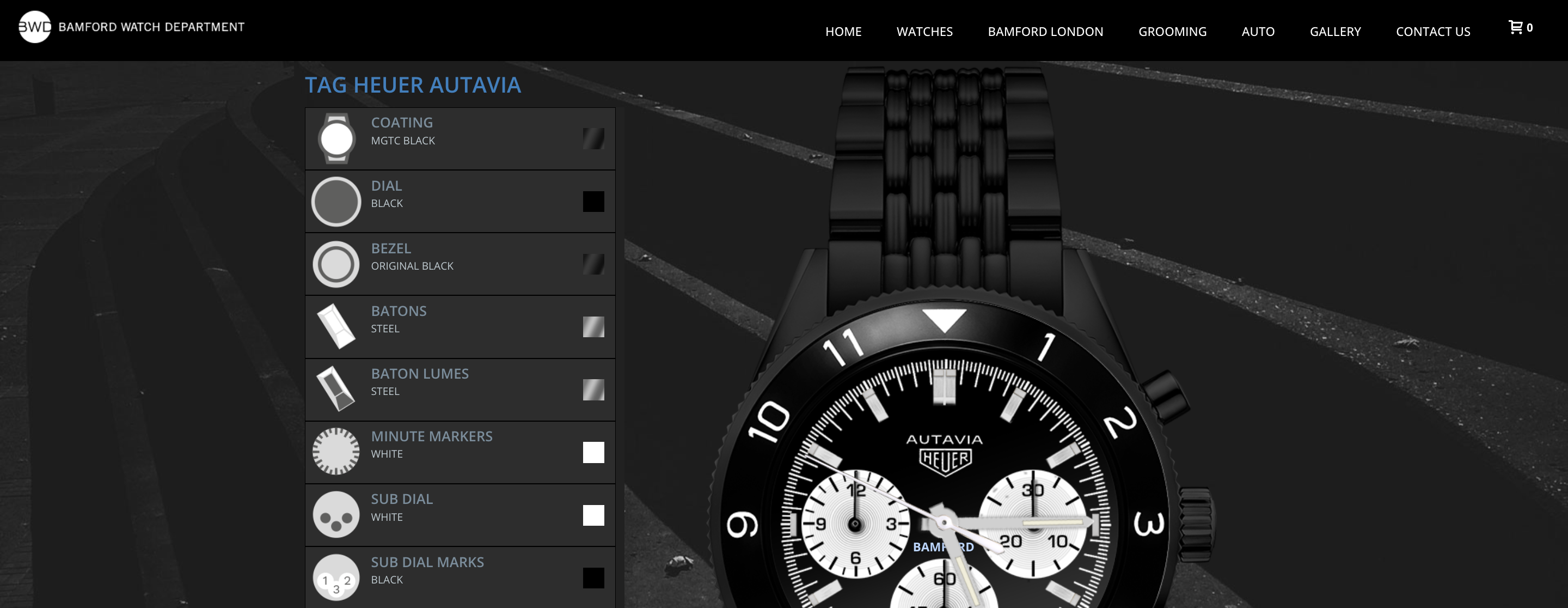
Bamford Watches serves as an excellent example of the successful application of eCommerce product configurator technology in the luxury watch industry. Their approach to product customization is both intuitive and visually appealing, offering a unique experience for online shoppers.
The Bamford Watches product configurator divides the user screen into two distinct parts. On the left side, users find customizable elements, while the right side displays a 2.5D model of the watch reflecting the user’s selections. This split-screen layout enhances the user experience by allowing real-time visualization of changes as they are made, thereby facilitating a more interactive and engaging customization process.
One of the notable aspects of the Bamford Watches configurator is the breadth of customization available. Users have the ability to edit almost every part of the watch, adding a personal touch to their luxury timepiece.
However, the configurator currently limits customization primarily to color options. While this offers a degree of personalization, it restricts the full potential of the configurator. Expanding the range of customizable features beyond just color would empower users with greater decision-making capability, further enhancing the user experience.
2. Nike
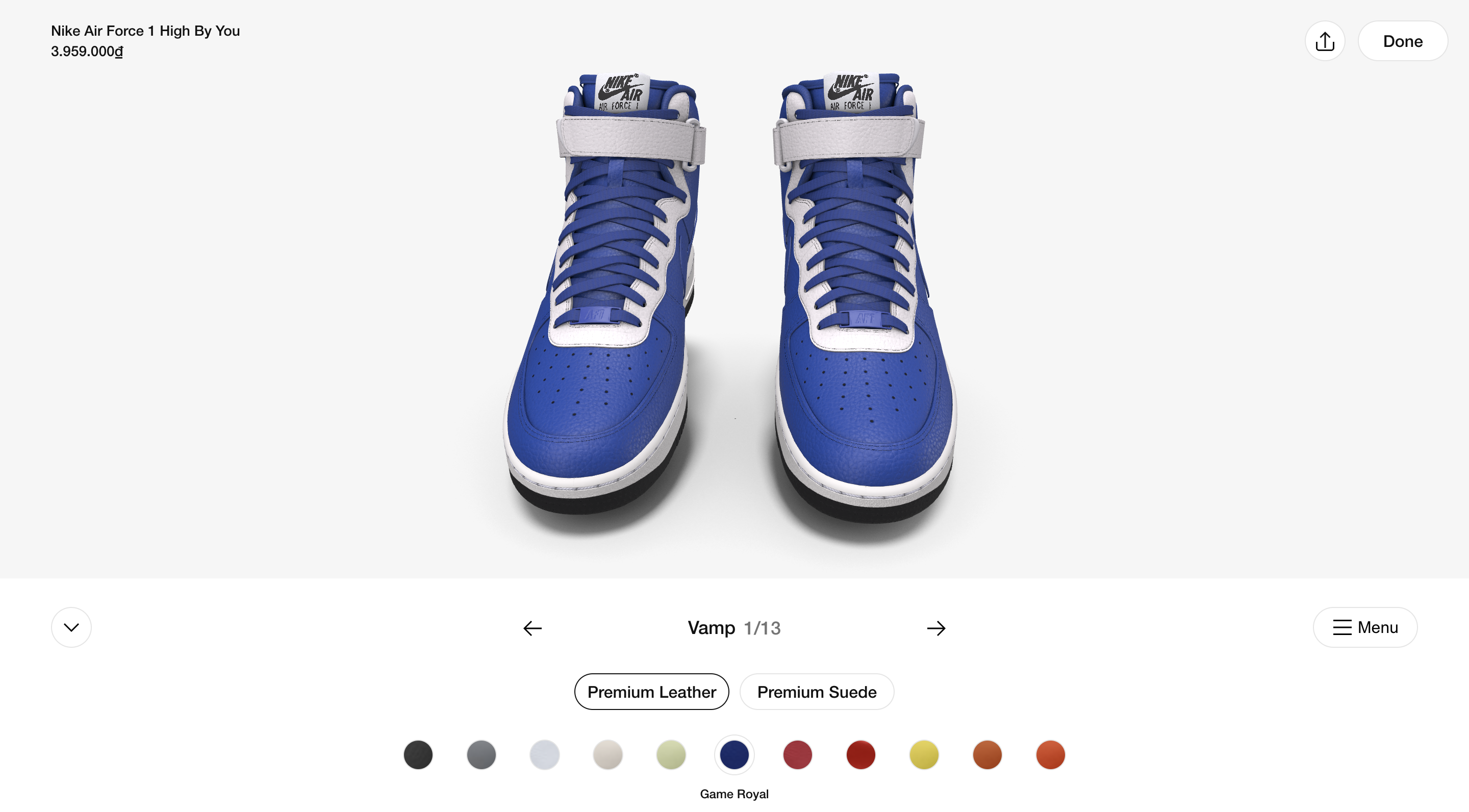
Nike’s implementation of eCommerce product configurator technology stands as a prime example of how well-established brands can leverage digital tools to enhance customer engagement and offer a more personalized shopping experience.
Nike’s product configurator, especially for their shoes, is a testament to their commitment to customer personalization. They provide detailed images of the shoes, accompanied by a wide array of customization options.
The level of detail in these images is impressive, allowing customers to get a clear and accurate view of what they are designing. Customers have the freedom to change the color of almost every aspect of the shoe, from the base to the laces, offering a highly personalized design process.
The user interface of Nike’s configurator is sleek and modern, aligning with their brand image. The customization process is interactive and user-friendly, making it easy for customers to select and visualize different color combinations and design elements. This interactivity not only makes the shopping experience more enjoyable but also gives customers a sense of ownership over the final product.
3. Ridley Bikes
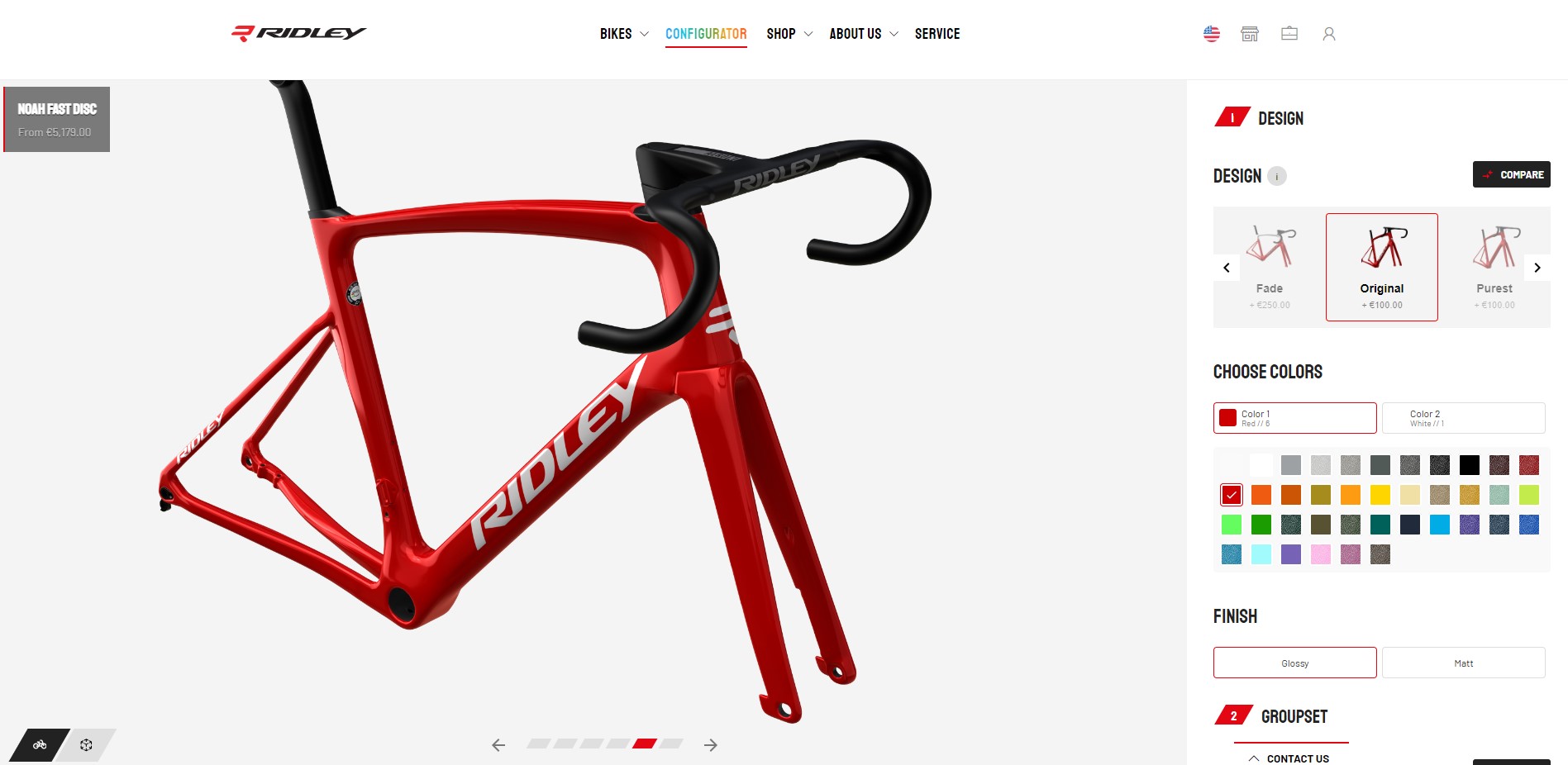
Ridley Bikes presents a noteworthy example of how an eCommerce product configurator can be effectively implemented in the cycling industry. Their approach to bike customization demonstrates a balance between detailed personalization and maintaining website performance.
Ridley Bikes’ configurator is structured to guide customers through the customization process in a sequential, step-by-step manner. This methodical approach allows users to focus on one element at a time, reducing the potential for feeling overwhelmed by choices.
Despite the length and complexity of the customization process, this step-by-step approach ensures that users can make informed decisions at each stage, tailoring their bike to their specific preferences.
An important aspect of Ridley Bikes’ configurator is its performance. By structuring the customization process into separate steps, the website effectively avoids lag or slowdown, which is crucial for maintaining a positive user experience, especially given the intricate nature of customizing a bike.
This careful balance between detailed customization options and website performance is a key strength of Ridley Bikes’ configurator.
Top 5 Ecommerce Product Configurator Software
1. Zakeke
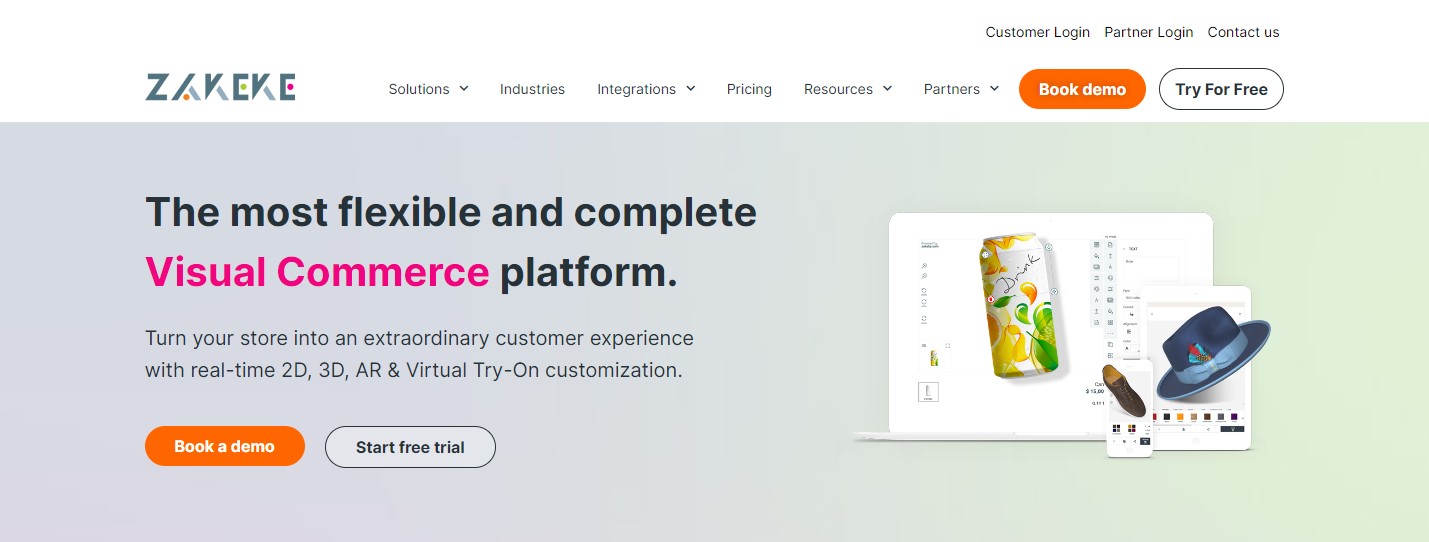
Zakeke offers a comprehensive suite of tools for visual customization, 3D and AR configuration, and virtual try-on capabilities. This platform empowers both retailers and brands to meet the rising consumer demand for personalized products.
Users of Zakeke can customize products with various elements like texts, images, materials, and colors, providing an interactive and engaging shopping experience before making a purchase.
Moreover, Zakeke supports integration with popular e-commerce platforms like Shopify, Walmart, and Magento. This integration simplifies the process for businesses to add customizable products to their online stores, enhancing the overall functionality and user experience.
2. Epicor CPQ
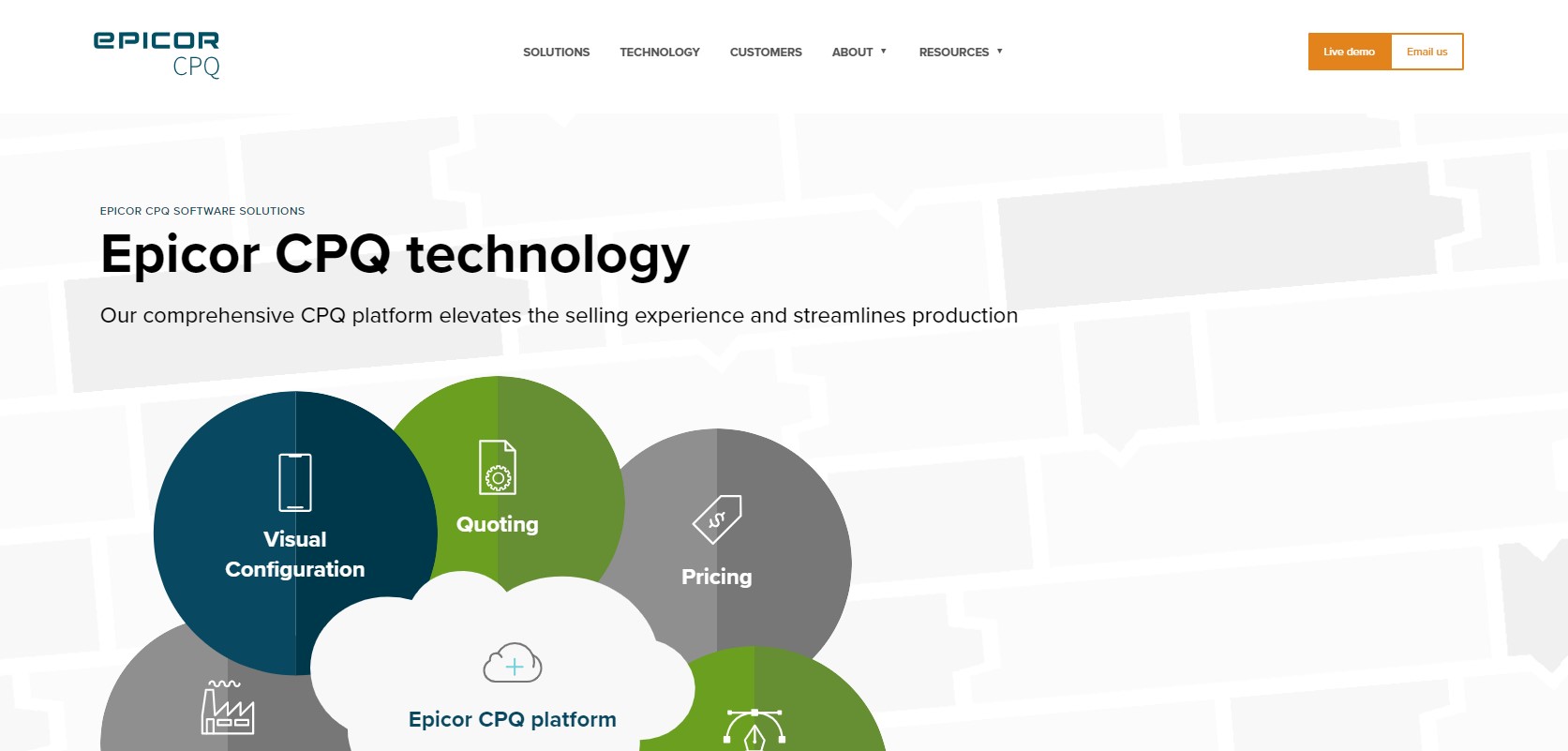
Epicor CPQ (Configure, Price, Quote), a cloud-based solution, is revolutionizing the way sales, engineering, and manufacturing processes are managed for complex and customizable products.
The platform is not just about visual customization; it significantly enhances efficiency by automatically generating prices, quotes, CAD drawings, and bills of materials. This level of integration and automation promotes agility, speed, and collaboration among teams, while also aiming to reduce costs.
Users have praised Epicor CPQ for its depth and the quality of support provided. It is recognized for its ability to significantly reduce the time taken for creating and configuring models. The ‘snap code’ and layout are user-friendly, and the support from Epicor’s product team, coupled with a comprehensive wiki, makes the learning process smoother and more efficient.
3. Combeenation
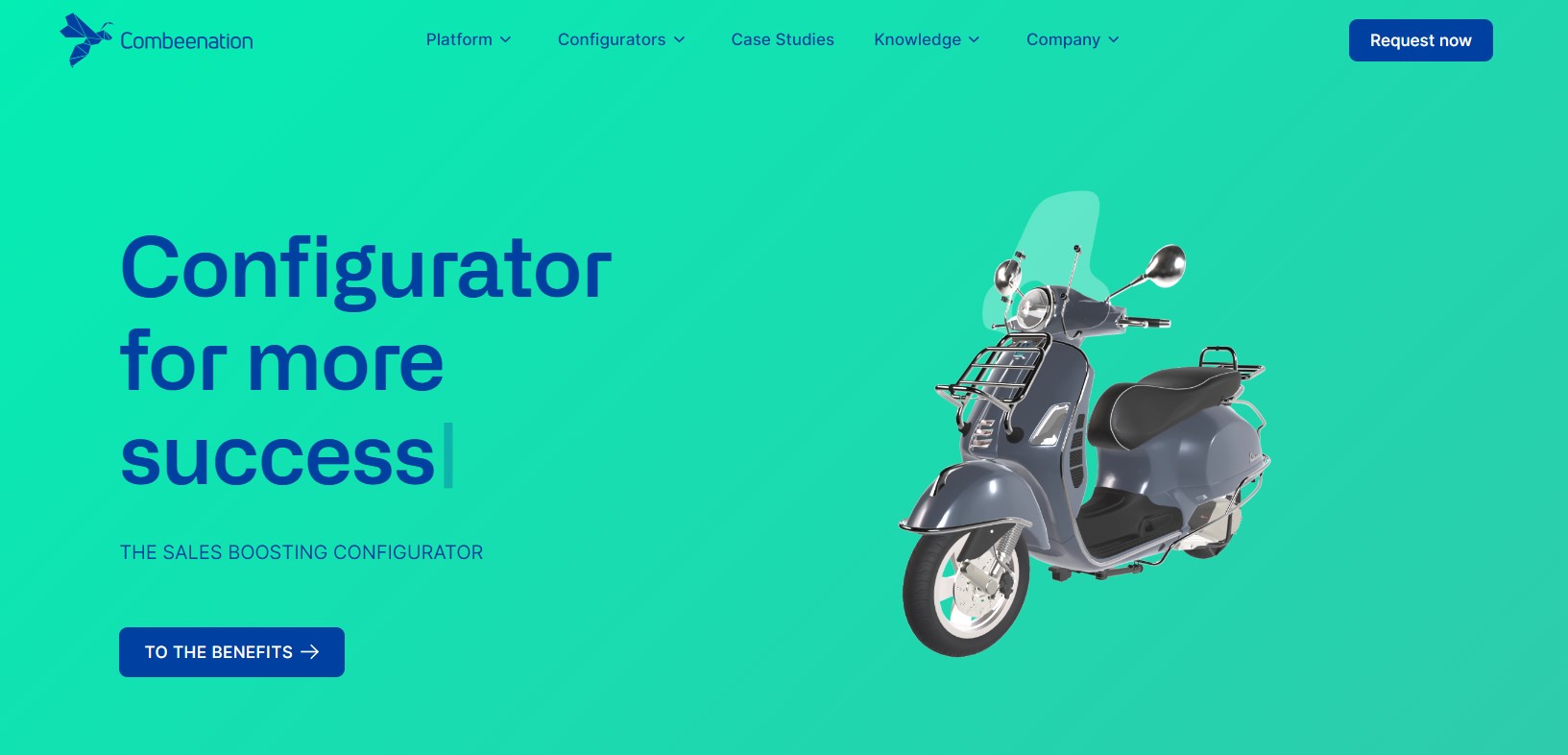
Combeenation has established itself as a provider of high-quality 3D configurators, known for their innovative technology and platform, earning the title of “The sales boosting configurators.”
Founded in 2009 and based in Austria, Combeenation has garnered global attention, serving customers from various industries including furnishing, mobility, consumer goods, and clothing. In 2020, the company was recognized as the “Mass Customizing Innovator of The Year,” a testament to its impact and innovation in the field.
Combeenation’s configurators are versatile, finding applications in almost every industry. This wide reach is a clear indicator of the configurator’s adaptability and effectiveness across different market segments. The configurators’ ability to enhance the user experience with detailed 3D models and animations has been a significant factor in their widespread adoption.
4. Dopple
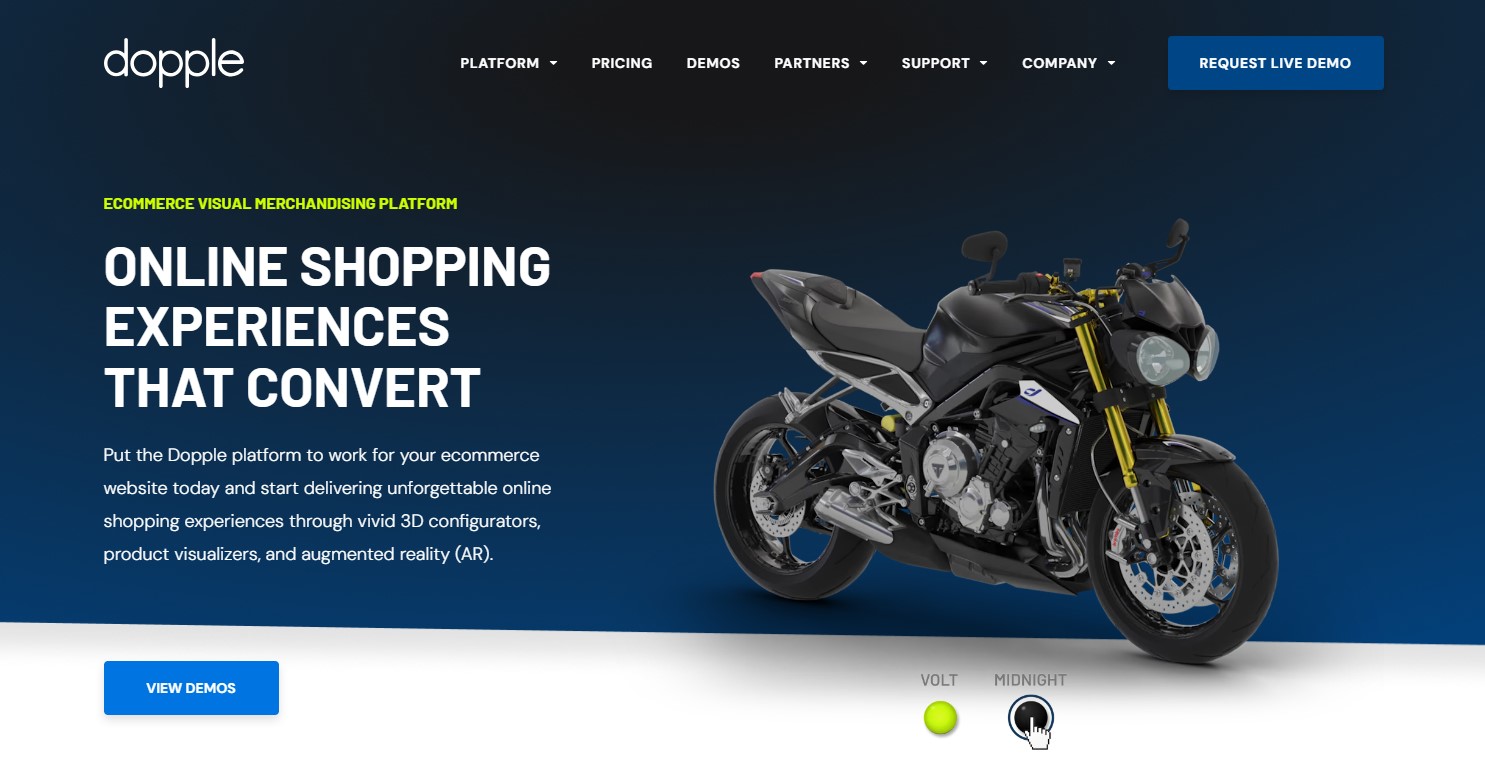
Dopple is at the forefront of digital product visualization, offering an innovative solution that enhances the online buying experience. By integrating 3D product visualization and configuration capabilities with other software providers, Dopple creates a connected data environment, enabling interactive and engaging digital product experiences for customers.
One of the key strengths of Dopple is its ability to understand and effectively integrate with a business’s product lineup, despite complexity or the number of parts involved. This deep understanding is reflected in the ease of implementation and integration with other platforms, as noted by users who found the process seamless and painless.
Dopple’s customer support and project management teams have been praised for their collaborative approach. They work closely with clients’ teams, including website companies, ensuring a harmonious and efficient implementation process.
5. Experlogix CPQ
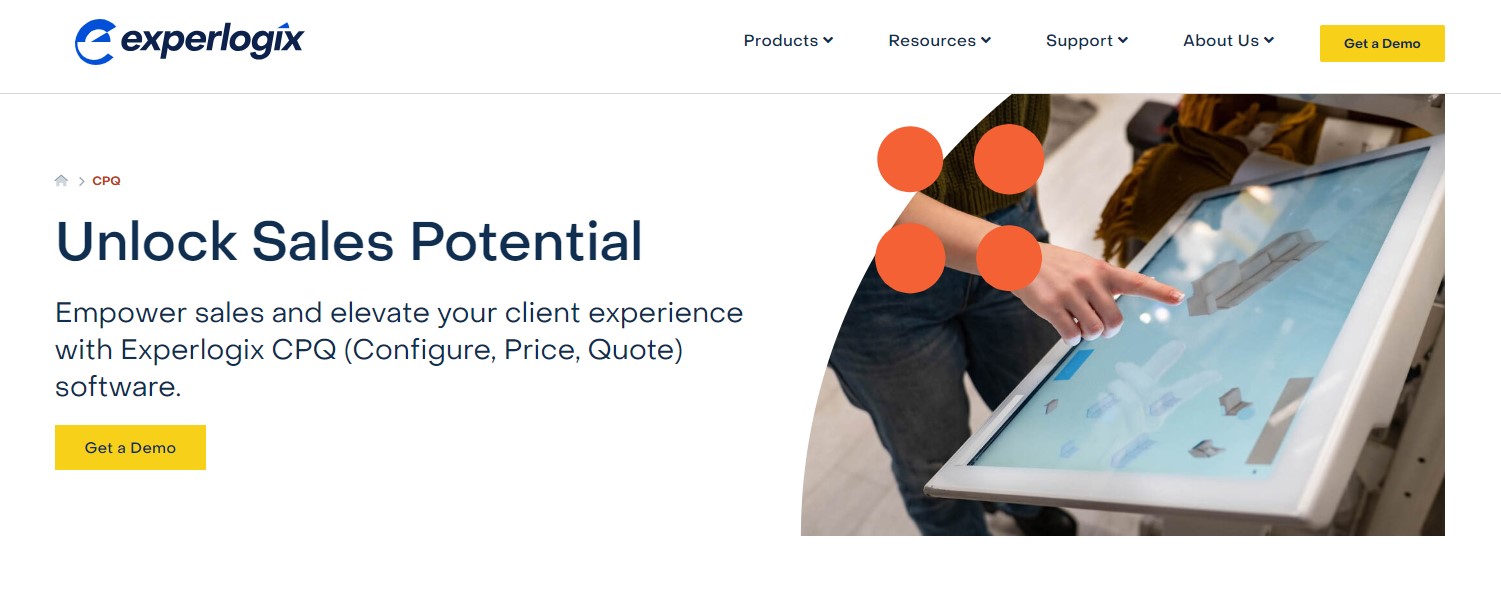
Experlogix CPQ is notable for its versatility across different sales channels – whether it’s direct sales teams, resellers, or B2B/B2C on the web. The software simplifies the quote-to-order process, enabling quicker and more accurate sales.
For manufacturing organizations, it seamlessly translates configured orders into detailed production orders, including BOMs (Bills of Materials) and routings, across various platforms like Dynamics 365, Salesforce, or NetSuite.
Users of Experlogix CPQ have highlighted its user-friendly design as a significant advantage, particularly for those with less technical expertise. This ease of use does not come at the expense of functionality; advanced users have access to a robust set of tools for building efficient configurators.

